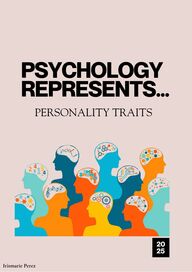
Return to flip book view
Message PSYCHOLOGYREPRESENTS...2025PERSONALITY TRAITS Irismarie Perez
What is psychology?Psychology is the study ofhow people think, feel, andbehave.
There are 5 pillars ofpsychology -Biological-Cognitive-Developmental-Social and Personality-Mental and Physical health*We will be focusing on Personality (which runson the 4th pillar)*Fun fact!Did you know that our brains areeven working while we are sleepingbecause its retaining all the memoryfor the day and removing any toxinsthat were building up.
What do personality traits mean?Personality traits are a person’s pattern of their thought,feeling and behavior It’s what makes all of us unique A part of our day to day lifeInfluences how we interact with people, manage toughsituations, regulate our emotions, etc The BIG FIVE personality traits are conscientiousness,openness, agreeableness, extraversion, and neuroticismOur traits emerge from early childhood and develop as weage Personality traits are connected to personality disorders
Openness: open-minded, willing to experience new thingsConscientiousness: A responsible person who has their selfput together Extraversion: Another way of saying extrovert, outgoing, avery social person Agreeableness: Emphathetic blunt person who will supportothersNeuroticism: Someone who experiences negative emotions(anxiety, lack of emotional stability, worry, insecurity)
Do these traits influence peer gradingleniency?Peer grading leniency is when your peer evaluatesyour work, put their feedback on it, and grades it.Traits do play a big role on influencingpeer grades as they either are morelenient with grading or not. -Academic entitlement andnarcissism were linked tomore lenient grading andlower grades due to lack ofeffort.-Agreeableness showed thatit had its ups and down withgrading leniency , andConscientiousness had agreat grade perfomance aswell as openess
Personality trait differences betweenmale and femaleFemaleFemale (Prosocial trait)(Prosocial trait)Show more emotionsShow more emotionsCreativeCreativeShow more agreeablenessShow more agreeablenesssupport one anothersupport one anothermALEmALE(Instrumental trait)(Instrumental trait)show more opennessshow more opennessAre more dominantAre more dominantHigh self esteemHigh self esteemrisk takerrisk taker
Personality DisorderPersonality disorders usually start early in life, continuinginto adulthood. They are considered a mental health conditiondue to the fact that its characterized by long listing patternsof behavior that differ from cultural standard. Disorders cancause you to not function properly ,struggle with your sociallife, have a distorted perception of yourself/others, adaptinginto a new environment ,and regulating emotions.
-Conscientiousness help people livelonger-Positive emotions can increase survivalAdditonal informtion-Neuroticism increases divorce risk-Agreeableness increases marriage-Also increases job success
Personality traits!